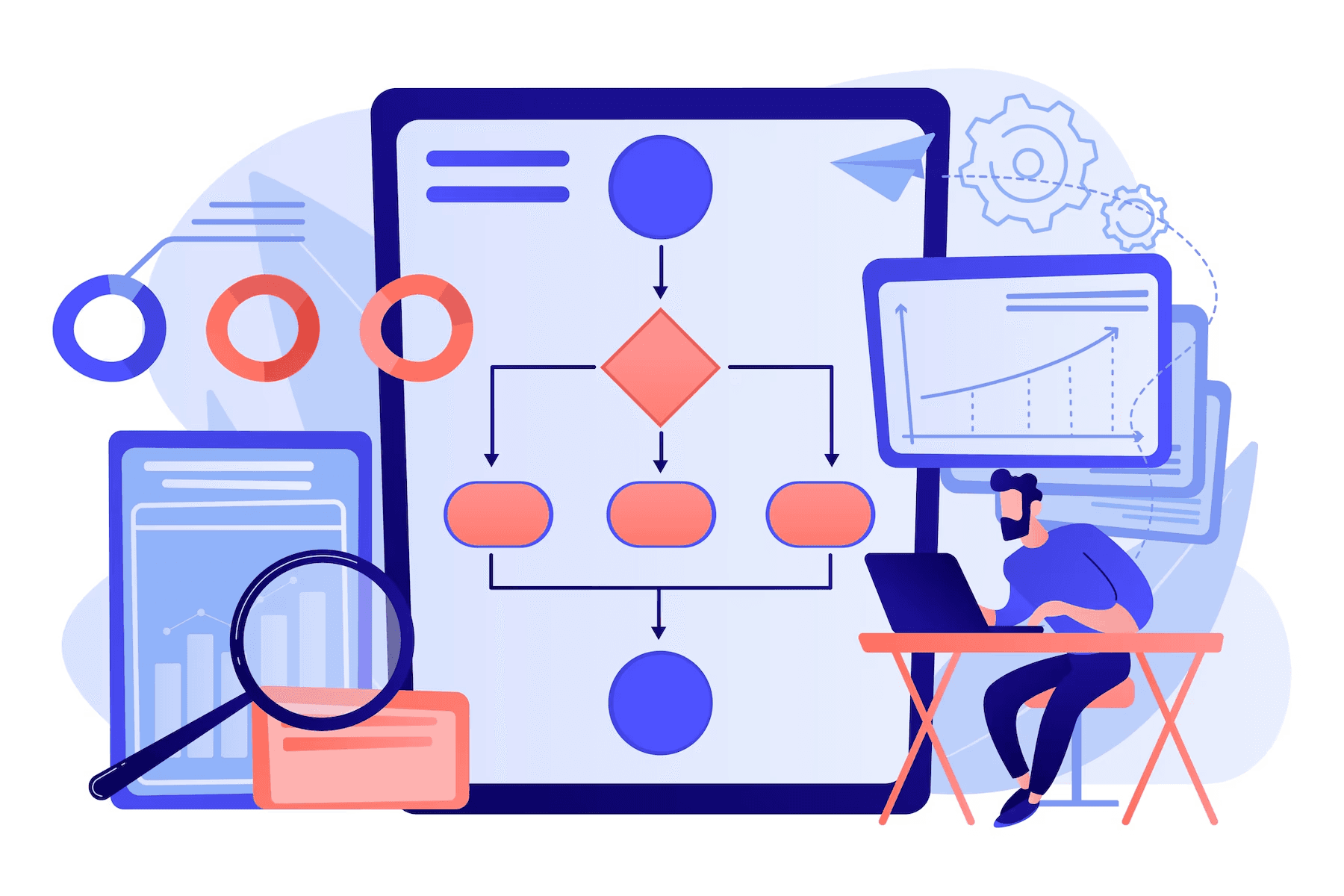Without clear task management, teams often face disarray, with roles overlapping and priorities shifting unpredictably. When teams operate without a project manager, the risk of confusion grows as different team members juggle multiple tasks and deadlines.
Establishing a well-defined task board workflow provides a solution that minimizes ambiguity, aligns team efforts, and ensures tasks are completed efficiently. This structure is essential for teams composed of diverse roles, such as designers, marketers, and content creators, enabling them to work collaboratively and achieve their goals seamlessly.
Defining Task Board Workflows
A task board workflow is not just a collection of tasks stacked together. It is a system that drives the project forward with precision. In teams without a project manager, each team member must possess the autonomy to execute tasks while staying aligned with the broader goals.
The workflow is the framework that ensures this autonomy operates smoothly. Task boards need to be meticulously structured, categorizing tasks in a way that mirrors the team’s specific responsibilities.
The primary goal of a task board in such scenarios is to remove ambiguity. Team members should not waste time figuring out who does what or when things are due. Every task should be clearly defined, with deadlines and owners assigned.
When roles are not centralized, task boards become the project’s backbone, dictating the rhythm of work and facilitating smooth transitions between stages of completion. Without clear workflows, even the best teams falter under the weight of miscommunication and missed deadlines.
Overcoming Common Challenges in Task Board Management
Managing task boards in a multi-disciplinary team introduces complexities that extend beyond basic task tracking. The most common challenge is ensuring that tasks dependent on multiple specialists, such as designers and marketers, progress without delays.
Designers are often waiting on content approvals, and marketers depend on designs to launch campaigns. Task board workflows must cater to these dependencies while making it clear who owns what, when, and why. Without a project manager, these dependencies can quickly cause bottlenecks. Task boards need to offer visibility into the status of tasks that depend on others.
This requires not just a to-do list but a comprehensive system where every task is linked to others through clear dependencies. Without this structure, the flow of the project halts, causing missed opportunities or stalled deliverables.
Prioritizing Tasks Across Multiple Specializations
One of the most significant obstacles for teams without a project manager is the competing priorities within diverse roles. A content marketer, a graphic designer, and a video editor all have different deliverables and timelines. Without a project manager’s centralized oversight, task boards must serve as a dynamic tool for prioritization.
Prioritization should be built into the workflow. Each task must be assigned a priority level, whether critical, high, medium, or low, allowing team members to focus on what matters most. When tasks span multiple roles, prioritization is vital to prevent the project from stalling.
Marketers need their creative assets on time, while designers require content direction to proceed. Task boards should offer clarity on which tasks to tackle first based on dependencies and urgency.
Tracking Progress Without Centralized Management
Tracking progress without a project manager means that team members are responsible for their deliverables, but the task board remains the central point of reference. It is not enough for tasks to simply be checked off. Each team member needs visibility into how far along they are, how close their dependencies are to being fulfilled, and what’s next.
Effective task board workflows include features like status indicators or color codes that offer immediate insights into progress. Tasks marked with “In Progress” should be visible to the entire team, signaling that the task is moving forward. Tasks awaiting input or approval should be flagged.
These markers not only provide clarity for the person working on the task but also for those waiting on its completion. The task board should act as a living, breathing document that evolves as work progresses, ensuring transparency and accountability.
Essential Features for Managing Diverse Workflows
Managing multiple workflows—creative design, marketing, social media, etc.—requires a task board that offers a high degree of customization. A generic task board won’t suffice when the project involves complex roles and interdisciplinary collaboration.
Essential features for such task boards include:
-
Customizable task categories that separate creative, marketing, and technical tasks to give clarity on roles and expectations.
-
Real-time collaboration tools such as comments or attached files, allow teams to work on tasks simultaneously without confusion.
-
Time tracking and deadlines that not only keep the team on schedule but also offer visibility into any potential delays.
With these features, task boards become far more than simple tracking tools. They become integral to maintaining order, alignment, and pace throughout the project.
Managing Task Dependencies
Dependencies are the silent drivers of most workflow inefficiencies. When one task cannot proceed until another is completed, it creates a chain of dependencies that must be managed. This is particularly true in marketing and creative workflows, where design often needs to align with content, and content strategies depend on the overall campaign direction.
A well-designed task board must highlight these dependencies. Whether through color-coded links or dependency flags, every task that cannot move forward independently must be visually connected to its prerequisites.
By mapping out task dependencies clearly, teams avoid confusion and ensure that no task is left hanging. This connectivity also ensures that delays are spotted early and can be addressed before they cause major disruptions.
Handling Revisions and Changes
Revisions are an inevitable part of the creative and marketing process. Without a project manager to ensure revisions are tracked properly, task boards must accommodate these changes seamlessly. When a task needs revision, the task board workflow should flag it clearly, assigning it to the relevant team members for updates.
Having a structured feedback system built into the task board workflow is essential. A designated space for comments, revision requests, and file uploads ensures that everyone knows when a task has shifted.
This feedback loop maintains the momentum of the project by preventing unnecessary back-and-forth, ensuring that every team member is up to date on changes without disrupting the overall progress.
Preventing Task Overload and Redundancies
Task overload is a frequent problem in teams without a project manager. Without centralized oversight, it is easy for tasks to be duplicated, or for team members to feel overwhelmed with responsibilities. Task board workflows must prevent this by clearly defining ownership and deadlines for each task.
Redundancy is eliminated when tasks are categorized correctly, and team members have visibility into each other’s workloads. The task board should have features that make it easy to see who is working on what and when it is due.
This clarity prevents overlap and ensures that no one is assigned multiple tasks that conflict with one another. It also ensures that everyone is working at optimal capacity without being overburdened.
Task Delegation in Manager-Less Teams
Task delegation in manager-less teams requires a more structured approach to accountability. While there is no project manager to oversee each task, there must be a clear delegation of responsibility from the outset. Every task in the workflow must have a specific owner, and each team member must know exactly what is expected of them.
Task boards facilitate this delegation by allowing clear assignment of tasks, tracking their progress, and ensuring that every team member is aware of their responsibilities. Through these tools, teams maintain transparency and ensure that accountability remains intact.
Managing Deadlines and Multiple Priorities
Managing deadlines in a team without a project manager demands an efficient workflow that prioritizes tasks based on urgency and impact. Deadlines are crucial, but they must be aligned with the project’s priorities. A task board workflow that integrates these priorities ensures that the most critical tasks are completed first, without missing deadlines for less urgent tasks.
Deadlines should be visible, and team members should be alerted when a task is nearing its due date. Prioritization within the board will keep teams focused on what matters most, ensuring that multiple competing deadlines are managed effectively. Task boards with built-in reminders and due date alerts help teams maintain pace and prevent missed deadlines.
Assessing Task Board Workflow Effectiveness
Measuring the effectiveness of a task board workflow is crucial to identifying areas for improvement. This requires tracking key metrics such as task completion rates, delays, and productivity levels. A workflow that is not assessed regularly will stagnate, leading to inefficiency and frustration.
Teams should actively monitor their task board to identify patterns of delays or bottlenecks. Gathering feedback from team members about their experience with the task board is also essential. These insights reveal weaknesses in the workflow and guide future improvements.
Minimizing Redundancies in Team Collaboration
Redundancy in task collaboration can cripple a workflow, especially in teams without a project manager. When multiple team members work on the same task without clear coordination, time and effort are wasted. Task boards mitigate this by creating a central location where everyone can see updates in real-time.
This prevents repeated efforts and ensures that updates are not lost in the shuffle. Setting clear rules for task updates—such as who updates the task and when—reduces confusion and duplication. This focus on streamlined communication is essential for a productive task board workflow.
Balancing Creative Freedom and Structured Workflow
Creative professionals need the freedom to innovate. However, marketing and other structured tasks demand consistency and deadlines. Balancing these two needs requires a flexible task board workflow that allows creative professionals to work freely within defined parameters.
Task boards should allow designers to manage their creative processes while ensuring that marketers are not left behind. The key is providing flexibility in how tasks are completed but maintaining deadlines and structure around them. This balance prevents stifling creativity while ensuring the project moves forward efficiently.
Customizing Task Boards for Diverse Teams
Not all teams function the same way. Task boards must adapt to fit the specific needs of each group, whether it’s a marketing, design, or social media team. Customization is essential for workflow optimization, allowing unique task categories, distinct priorities, and tailored progress tracking to accommodate various demands.
For example, marketing campaigns might require content calendars, while designers benefit from visual boards with detailed asset stages. Flexibility ensures all team members align with their workflow preferences while maintaining unified project goals.
Task boards should seamlessly integrate individual and collective workflows, facilitating collaboration and eliminating confusion without compromising the team’s productivity standards. This customization ensures task boards remain central to diverse team success.
Conclusion
Streamlining task board workflows in teams without a project manager requires careful planning, clear task delegation, and effective tracking of progress. By integrating task dependencies, prioritizing roles, and maintaining flexibility, teams can work efficiently, stay organized, and achieve their project goals without a centralized project manager.
Effective task board management empowers teams to handle complex projects while fostering collaboration and accountability. For teams looking for an affordable, streamlined solution,
Pinrom provides a robust platform at just $1/user, making it an ideal choice for efficient task board management.







